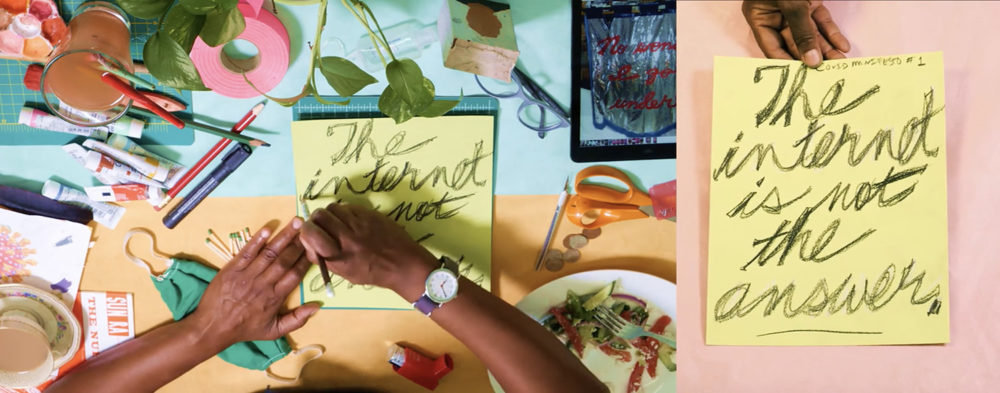
- Source: The New York Times
- Author: Alwa Cooper
- Date: August 27, 2021
- Format: Digital
Sticky Note Manifestoes Written During Quarantine
The artist Cauleen Smith talks about her new video work and the music she finds life affirming.
In each installment of The Artists, T highlights a recent or little-seen work by a Black artist, along with a few words from that artist putting the work in context. This week, we’re looking at elements of a video work by Cauleen Smith, the full version of which will premier online via Pittsburgh’s Carnegie Museum of Art (CMOA) on Sept. 3. (Aspects of the work will appear, too, in the museum’s lobby.) Smith also has solo shows at the Contemporary Arts Museum Houston and LACMA on view now.

A still from Cauleen Smith’s “Covid Manifesto” (2020-2021). Courtesy of the artist and Corbett vs. Dempsey, Chicago
Name: Cauleen Smith
Age: 53
Based in: Los Angeles
Originally from: Sacramento, Calif.
Where and when did you make this work? The original “Covid Manifesto” videos that make up “Pandemic Diaries,” the exhibition at CMOA, were shot last October, here in Los Angeles, while everybody was quarantined. It was a bit of a process, but I shot them pretty much just on a tabletop in my studio.
Can you describe what’s going on in the works? You basically only see my hands writing, which is based on these sticky notes I was scrawling on and posting photos of to Instagram during quarantine. They’re more formally presented in the videos — I write out screeds and complaints and laments about things that I was experiencing, or things that I was noticing about what the pandemic was revealing about our society. You see a very skewed, disorienting perspective of a surface that’s just covered in mundane objects and materials, everything from a face mask to an inhaler — pencils, flowers, houseplants, record albums, books, rocks, seashells, food, beverages — all surrounding the piece of paper that I’m writing on. When I made the videos I was really thinking about Manny Farber, who was an amazing film critic but also an amazing painter, who made these really interesting still lifes that are an ongoing obsession for me. It seemed like the perfect form for the experience of being quarantined.
What inspired you to make them? I was invited to make the videos that became part of the larger work by Josef O’Connor, an artist in London who’s running this program called CIRCA, for which he gets two minutes every night to show artwork on the Piccadilly Circus video screens. He’s been curating it with a really amazing range of artists like Ai Weiwei, Patti Smith and Anne Imhof. He originally just wanted the sticky notes I’d been putting on Instagram, but, being a filmmaker, I couldn’t just let it lie at that, especially when we were talking about the largest video screen of its kind in Europe. I wanted to really occupy that space and fill the whole screen. If I were to say anything about the Covid videos, it’s that I thought the virus would be over by now. I find it endlessly fascinating how the shock waves of dealing with the virus — or failing to deal with it — just keep presenting themselves to us. I don’t know if I’m really happy about the fact that these silly sticky notes that I was writing back in March are still relevant today, but it’s an interesting fact, and I’m grateful that there’s a place for this work to exist.
What’s the work of art in any medium that changed your life? It would probably be music, maybe something like Stevie Wonder’s, in the seventh grade. Or something later — I’m just now learning about a Black composer, Julius Eastman, and being blown away by his work. It’s making me rethink the entire last half of the 20th century, in terms of minimalism and modernism, and sound and theatricality. Minimalism can be so pregnant with discourse and resistance and protest, and maybe it’s not changing my life, but it’s definitely life affirming to know of this artist — and it’s also infuriating to know how completely ignored and marginalized and unappreciated he was in his lifetime. Eastman’s N-word series is the work by him that I’m really obsessed with, but I don’t think you can go wrong. You could even listen to the scores that he made for some of the choreographers back in that age, which are pretty accessible on YouTube and all just phenomenal. Another life-changing musician might be Sun Ra, who I think basically taught me how to make the work that I’m making now. So if there is really an artist who changed my life, it would be Sun Ra for sure.
This interview has been edited and condensed.

